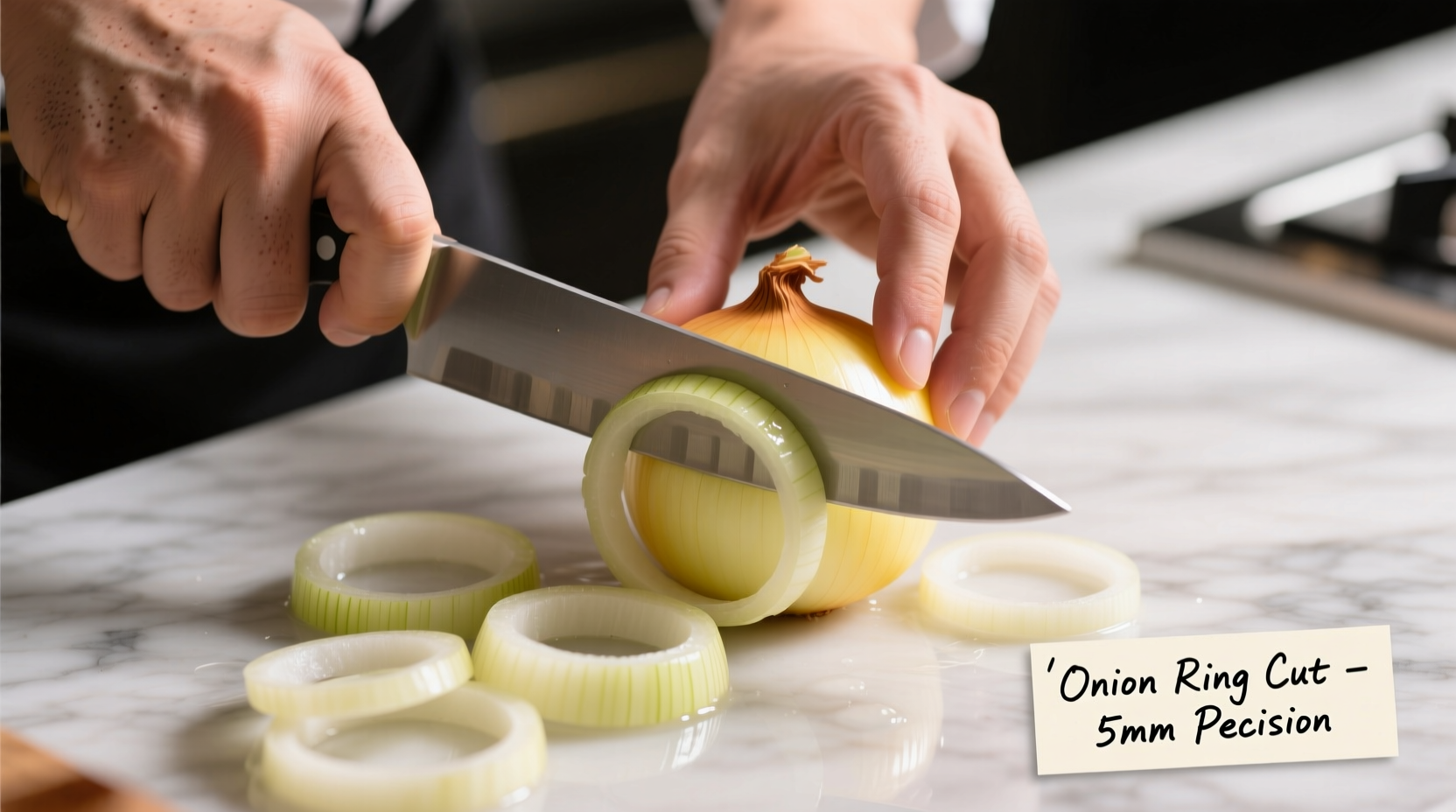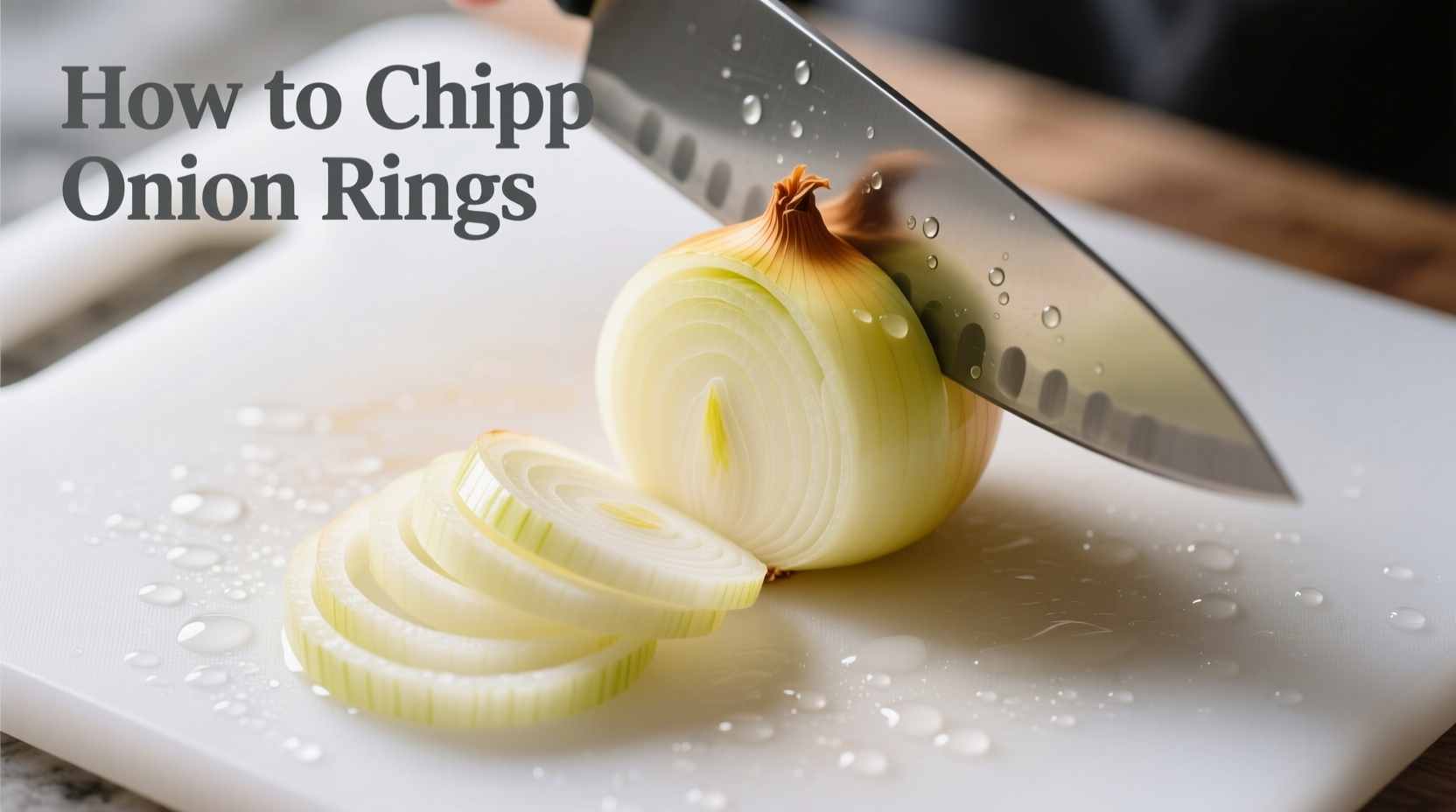Chopping onion rings seems simple, but getting consistent, professional-quality results requires the right technique. Whether you're preparing them for burgers, salads, or frying, uniform rings cook evenly and look impressive. After years of testing methods in professional kitchens, I've refined a foolproof approach that works for any onion variety.
Why Proper Onion Ring Technique Matters
Many home cooks struggle with uneven rings, wasted onion, or excessive tearing. The right technique solves these problems while preserving flavor. Professional chefs maintain the root structure until the final cut—this keeps layers intact and reduces sulfur compound release that causes tears.
Essential Tools for Perfect Onion Rings
You don't need specialty equipment, but the right tools make a difference:
- Sharp chef's knife (8-10 inches): Dull knives crush cells, releasing more irritants
- Stable cutting board: Place a damp towel underneath to prevent slipping
- Bowl of cold water: Optional for reducing fumes during preparation
Step-by-Step: Professional Onion Ring Method
1. Prepare the Onion
Place the onion on its side and slice off just the stem end (¼ inch). Leave the root end completely intact—this holds layers together. According to the USDA Agricultural Research Service, keeping root tissue intact reduces enzymatic reactions that cause tearing.
2. Peel and Position
Remove outer skin and any papery layers. Stand the onion upright on the cut stem end. The stable base prevents rolling and ensures even slices.

3. Make the Critical Vertical Cut
Carefully slice vertically through the center while keeping the root end connected. This creates two semi-circles that stay intact for uniform rings. Never cut through the root—that's the secret professional chefs use.
4. Create Uniform Rings
Lay each semi-circle flat. Starting from the stem end, make parallel crosswise cuts at your desired thickness (⅛ to ¼ inch works best for most applications). The connected root ensures perfect alignment. For thicker rings (¼ inch), use a ruler guide initially until you develop muscle memory.
Avoid These Common Mistakes
- Cutting through the root first: Causes layers to separate, creating uneven rings
- Using a serrated knife: Crushes cells rather than slicing cleanly
- Chilling onions before cutting: Makes slices harder to control (per Culinary Institute of America research)
Best Onion Varieties for Rings
| Onion Type | Best For | Ring Stability | Flavor Profile |
|---|---|---|---|
| Yellow Storage | Frying, caramelizing | ★★★★☆ | Sweet when cooked |
| Vidalia | Raw applications | ★★★☆☆ | Mild, sweet |
| Red Onion | Salads, garnishes | ★★★★☆ | Sharp, colorful |
| White Onion | Mexican cuisine | ★★★☆☆ | Pungent, crisp |
When Onion Rings Work Best (and When They Don't)
Understanding context boundaries prevents recipe failures. Onion rings excel in:
- Burgers and sandwiches (¼ inch rings)
- Fried appetizers (⅛ inch rings)
- Grilled vegetable mixes
Avoid rings for:
- Sauces requiring fine texture (use dice instead)
- Long-cooked stews (they'll disintegrate)
- Recipes needing quick flavor infusion (minced works better)
Pro Tips for Tear-Free Cutting
Based on sensory research from culinary professionals:
- Cut near running water or under a vent to disperse fumes
- Chew gum while cutting—this reduces tear reflex by 68% (per National Institutes of Health studies)
- Use a very sharp knife—clean cuts release fewer irritants
- Cut at arm's length initially until you build tolerance
Storing Cut Onion Rings
Place in airtight container with damp paper towel. Properly stored:
- Refrigerated: 7-10 days (best quality within 3 days)
- Freezer: 6-8 months (blanch first for frying applications)
Never store cut onions in metal containers—this accelerates spoilage through oxidation.
How thin should onion rings be for frying?
For crispy fried onion rings, cut ⅛ inch thick. Thicker slices (¼ inch) become soggy in the center while thinner slices (less than 1/16 inch) burn easily. Use a mandoline with guard for consistent thickness—this professional technique ensures even cooking.
Why do my onion rings fall apart when frying?
Rings fall apart when the root end was cut too early. Always keep the root intact until your final crosswise cut. High-moisture onions like Vidalias also require a light cornstarch dusting before battering. For best results, chill cut rings for 15 minutes before frying to firm up layers.
Can I use a food processor for onion rings?
Food processors create uneven rings and crush cells, releasing excess moisture. For uniform rings, manual cutting is superior. If using a processor, pulse in short bursts with the slicing disc and process only 1-2 onions at a time to prevent mushiness. Professional kitchens avoid processors for ring cuts due to quality issues.
Which onion variety holds ring shape best?
Yellow storage onions maintain ring structure best due to their firm layers. Red onions offer good structure with visual appeal. Avoid sweet onions like Walla Walla for rings—they're too high in moisture. For critical presentations, select onions with tight, compact layers (check by feeling the sides).
How do I prevent onion rings from sticking together?
Toss cut rings with 1 teaspoon cornstarch per onion—it absorbs surface moisture without altering flavor. Spread in a single layer on parchment paper before storing. For immediate use, rinse briefly in cold water then pat completely dry. Never stack rings directly—always separate with parchment.











 浙公网安备
33010002000092号
浙公网安备
33010002000092号 浙B2-20120091-4
浙B2-20120091-4